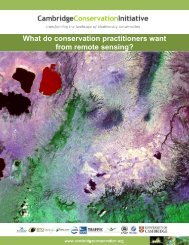CONSERVING BIODIVERSITY & DELIVERING ECOSYSTEM SERVICES
conserving biodiversity & delivering ecosystem services
conserving biodiversity & delivering ecosystem services
Create successful ePaper yourself
Turn your PDF publications into a flip-book with our unique Google optimized e-Paper software.
In 2011, an expert consultation indicated that the supply<br />
of harvested wild goods, including food, fibre, fuelwood<br />
and natural medicines, was likely to be decreasing at over<br />
half of the IBAs that deliver these as one of the most<br />
important services. Around one-third of sites showed an<br />
increase in this service. Recreation and tourism is<br />
reportedly on the increase at 95% of IBAs where it occurs.<br />
There is also a reported increase in supply of cultivated<br />
foods at some sites although this is likely to be at the<br />
expense of other services. Global climate regulation is<br />
believed to be stable or increasing across most of the sites,<br />
as is water provision (see figure).<br />
Proportion of IBAs delivering ecosystem services with increasing,<br />
stable or decreasing trends over the past five years<br />
Numbers in brackets represent the number of sites at which the service was recorded as<br />
being the 5 most important. Only these sites are included in each column, and only<br />
services that were important at >5 sites are presented.<br />
SOURCE Based on information provided at an expert consultation workshop.<br />
Local stakeholders discuss the changes to habitats and impacts<br />
on ecosystem services occurring at Koshi Tappu Wildlife Reserve<br />
over recent years (Jenny Birch)<br />
A similar exercise with local stakeholders at Rara National Park<br />
(David Thomas)<br />
An example from Koshi Tappu Wildlife Reserve IBA<br />
Koshi Tappu Wildlife Reserve is an IBA and Ramsar site in the Terai of south-east Nepal. A mosaic of open water, riverine<br />
habitats and seasonally flooded grasslands, it supports tens of thousands of waterbirds and is also important for the<br />
globally threatened Ganges River Dolphin and home to Nepal’s last population of wild Asian Water Buffalo. However, since<br />
the 1990s the number of waterbirds visiting the reserve has dropped dramatically.<br />
“Wetland species undoubtedly face the greatest threats in Nepal. One example is Black-bellied tern which occurs on lakes and<br />
rivers in the lowlands, and which has all but disappeared from Koshi, as a result of widespread food shortages” says Top Khatri,<br />
National Programme Manager for the ‘Conservation and Sustainable Use of Wetlands in Nepal’<br />
project. “The food of the tern—fish—is also an important resource for people, particularly those from<br />
poorer communities, and the birds are indicating that this important resource is diminishing. To reduce the<br />
conflict between livelihood needs and conservation objectives, we need to develop sustainable options that<br />
can deliver material benefits to local people whilst preserving the ecological integrity of the wetlands”.<br />
For more details of this study, see p.29.




